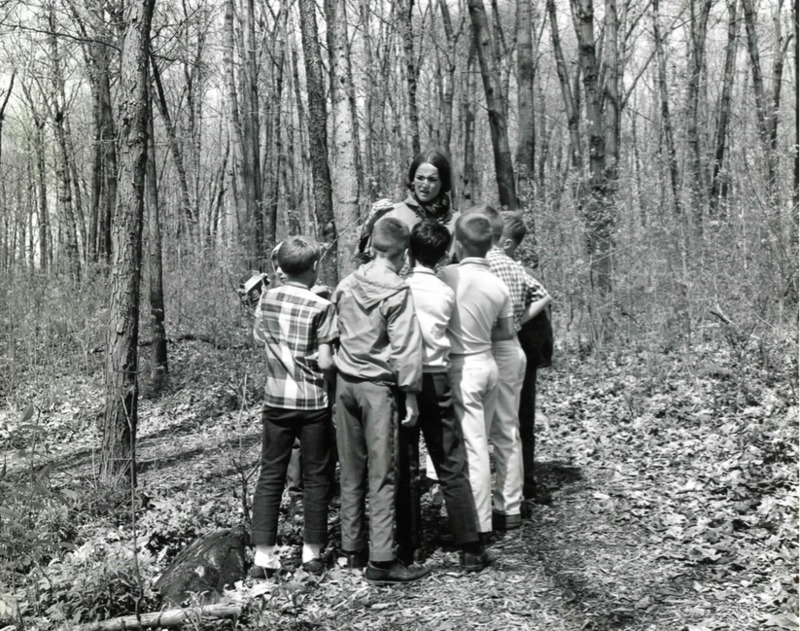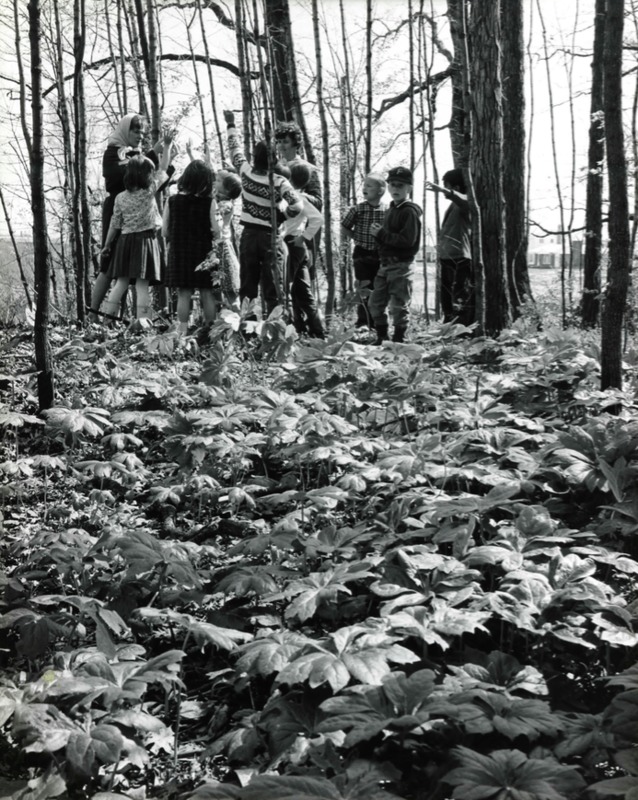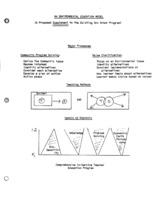Educating Ann Arbor's Youth
Because of the coverage of environmental issues in the local papers, a strong outdoor education program in the public schools, and the early activist efforts of many residents, many young Ann Arborites had a strong sense of environmental awareness before the U-M Teach-In and the first Earth Day in 1970. In 1961, a community-wide group of citizens successfully petitioned the Board of Education of the Ann Arbor Public Schools to lead the nation with an innovative outdoor education program, which incorporated environmental field trips, slide shows, and guest lecturers into the K-12 curriculum and warranted a full-time coordinator. Over the next few years, as the initial excitement about the program faded, so did the available funding. What remained of the Ann Arbor program was disjunctive and inadequate, offering one field trip per elementary school class per year and a limited number of conservation courses for students beyond grades K-6. “Due to the scheduling process, electives, counseling, etc.,” Bill Browning, the director of the outdoor education program in Ann Arbor, wrote, “there are many students (perhaps a majority) who do not receive any coherent, logical program that would cover the ‘environmental education’ field,” especially in secondary schools. Out of the increased concern garnered by the growing sense of an environmental ‘crisis’ in the late 1960s came a reiteration of environmental education which encouraged students to not only explore the natural environment but also to develop environmental appreciation, to work towards its protection, and to encourage active citizenship.
“Environmental Education is a process, one that begins in the early years of elementary school, where children explore the natural environment and become sensitive to it. Most importantly, children learn that they are a dependent and inseparable part of that environment.”
Since its beginning, the Ecology Center of Ann Arbor has provided voluntary assistance to local public schools and especially to individual teachers in areas such as curriculum design, classroom teaching techniques, and field trip planning. At the Ecology Center library, the staff maintained a folder of environmental education materials available for teachers, which included original Ecology Center curriculum ideas, visual aids, games, and activity guides. Within the community, the Ecology Center promoted all their outreach events, especially the Community Organic Garden, to families and teachers and conducted ecology training sessions in local neighborhoods. In 1972, the Ecology Center conducted a weekly class at the Northside Neighborhood Center, including hiking nature trails, gardening, tasting organic foods, and completing a project to improve the neighborhood.
In response to years of Ann Arbor citizens, teachers, and students expressing their concerns about the program’s deterioration, a community-wide group of interested citizens, many of whom were Ecology Center leaders and members, convened in the early months of 1973 to review the local program and to discuss the possibilities for its revitalization. Over the next couple months, the Board reviewed current literature about theories of learning and instruction in environmental education, discussed recommendations for curriculum changes, and assessed the opportunity for increased connection to community groups and local resources. The product of these meetings was a formal proposal to the Ann Arbor School Board, which emphasized increasing community-wide environmental awareness, expanding opportunities for students to identify, study, and work on environmental issues, and encouraging cooperation between communities, schools, government agencies, and environmental groups like the Ecology Center.
With the expansion of the Environmental Education Program in Ann Arbor, the Center seized the opportunity to expand its role alongside the program, taking an active role in deliberations about the public school program’s future and updating and enhancing its own resources and community outreach initiatives. Two major additions to the existing resources were the development of an analytical file on local environmental issues and a Current Environmental Topics program. The analytical file contained detailed descriptions of the sites and histories of many local environmental issues, such as the Briarwood development, transportation, land use, and water resources problems with the Huron River, along with an impact analysis of each problem. To supplement the information, the Center would also include visual materials, such as slides and charts, which teachers could access for classroom use. With the Current Environmental Topics program, the staff at the Center would develop informational materials for classrooms for local, state, and national issues as they appeared in the hundreds of newsletters they received from organizations across the country. For local environmental issues, the Center would create materials on issues discussed at City Council and Planning Commission meetings and on issues of concern to local environmental groups, neighborhood organizations, and teachers. Additionally, the Center provided “individual assistance to teachers in areas of curriculum design, processes of value clarification and development of environmental encounters oriented toward community problem-solving.” Still today, the Ecology Center remains committed to improving environmental education in Southeast Michigan through classroom programs, educator resources, and recycling education.




